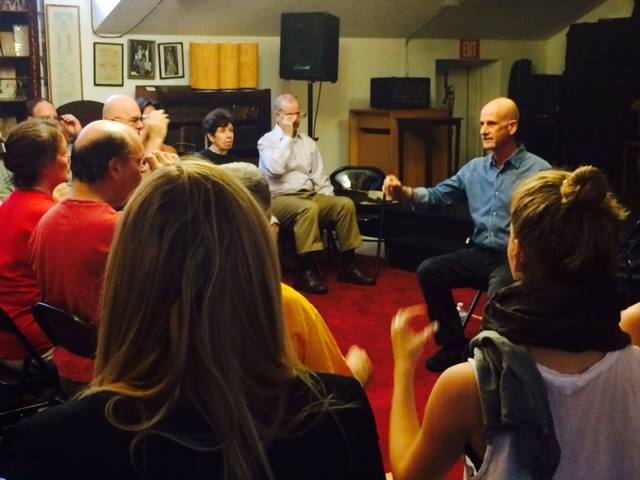 Alexander Technique in New York City is a challenge. Applying the Alexander Technique to bike riding in New York City is a bigger challenge! For my first bike (bicycle) ride with my new bike, I chose to be near NYC. This was my first ride in quite a few years. It’s funny how once you’ve learned this skill, it stays with you forever. It’s kind of like riding a bike…anyway, it was great to be riding again; supplying my own power, the wind rustling through where my hair used to be. However, since I’ve been studying and teaching the Alexander Technique for quite a few years now, I realized all the ways in which the Alexander Technique and bike riding are made for each other.
Alexander Technique in New York City is a challenge. Applying the Alexander Technique to bike riding in New York City is a bigger challenge! For my first bike (bicycle) ride with my new bike, I chose to be near NYC. This was my first ride in quite a few years. It’s funny how once you’ve learned this skill, it stays with you forever. It’s kind of like riding a bike…anyway, it was great to be riding again; supplying my own power, the wind rustling through where my hair used to be. However, since I’ve been studying and teaching the Alexander Technique for quite a few years now, I realized all the ways in which the Alexander Technique and bike riding are made for each other.
With most bikes you have to lean forward. Where does that lean, or hinge happen? Anywhere you want but, as the Alexander Technique teaches us, some places are more beneficial than others. You could create a hinge at the waist. If you hinge at the waist, you’re also hinging from the lower back. You may be hinging around lumbar disc 5 and sacral disc 1 (L5-S1) a place orthopedic surgeons know very well. However, there are other choices. “Wheely?” you may ask. Yes. There’s a place further down from the waistline where you could hinge. I like to call this hinge point ‘the hip joints’, because they are. They’re sort of where the legs meet the torso. That’s a beneficial place from which to hinge for bike riding, reaching for a cup of coffee while seated, or the first move as you stand up.
But if you hinge at the hip joints, and let your spine act as one integrated unit you may notice that you’re looking only about two feet in front of you. That’s bad for you and the woman with the baby carriage ten feet ahead of you. We need another hinge, and I know where we could get one, or two. They’re where the head meets the spine, the atlanto-occipital joints.
The AO joints (as well as the hip joints) are the bike rider, computer user, guitar player, coffee reacher, and food eater’s friend. Of course we could also make a choice to hinge at the base of the neck, between cervical disc 6 and cervical disc 7 (C6-C7) another popular meeting place for orthopedic surgeons, but there’s no real hinge there either. Not so beneficial. We need to hinge from further up. Imagine a rod going through your head at the height of your ear holes, and pivoting your head up and down from there. This is using your AO joints. So, if you pivot with your hip and AO joints, you’re using your body the way it was designed. You’re practicing the Alexander Technique.
Now ride! Use that computer! Play that guitar! Eat that food! Reach for that coffee! Your spine is thanking you for leaving it alone.
Mark Josefsberg-Alexander Technique NYC
(917) 709-4648










which type of bike do you reccomend?
Hi,
I guess it depends on what you’re riding for. Do you want a racing bike? A mountain bike? A street bike?
Once you figure out what you need, you could go online and do some research. Maybe go to a bike store and ask questions, and try out a few. There’s lots of people out there who know lots about bikes!
Best,
Mark
One humorous thing is ,
a champion in bike riding sits on a bike in a wonderful satisfactory direction while directing unconciously with habit.
But,
he goes home, and sits slumped with head down, infront of his wife.
Hi Rajesh,
Yes, especially if he doesn’t like his wife. Some champion bike riders might sit with his wife and slump, while others wouldn’t. Same as average bike riders!
The Alexander Technique might help both. And the Alexander Technique might help both wives and husbands as well!
.Good explanation.
But,
you not explained the shoulders arms, legs where to keep with the AO, HIP hinges.
Please explain to know myself.
Hi Geetha,
You want your shoulders as free as possible, and not lifted unnecessarily. Think of your legs moving away from your torso. Using the Alexander Technique while bike riding includes using at least two sets of hinge joints. You can pivot forward using the hip joints, and look up using the AO joints. Think of your neck being as free as possible.
[…] I found a bunch of articles, e-books and the like on this subject. Here is one on cycling and AT. Here is a blog post written by Mark Josefsberg, fellow New Yorker, on AT and cycling in NYC! And […]